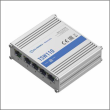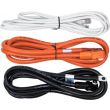Back to Top
Zener Diode 3.3V 500mW 5% DO35
Zener Diode 3.3V 500mW 5% DO35:
The Zener Diode 3.3V 500mW is designed for voltage regulation and clamping applications. It provides a stable 3.3V reference voltage, making it suitable for use in low-power circuits such as voltage regulation, reference generation, and over-voltage protection.
Specifications:
- Zener Voltage (V_Z): 3.3 V
- Tolerance: 5%
- Power Dissipation: 500 mW
- Package Type: DO-35
- Zener Impedance (Z_Z): 28 Ω (at I_Z = 20 mA)
- Maximum Zener Current (I_ZM): 152 mA
- Reverse Leakage Current (I_R): 5 µA (at V_R = 1 V)
- Forward Voltage (V_F): 1.1 V (at I_F = 10 mA)
- Operating Temperature Range: -65°C to 200°C
- Applications: Voltage regulation, voltage reference generation, and over-voltage protection
| SKU | DIO-0004-B01 |
|---|
Write Your Own Review









